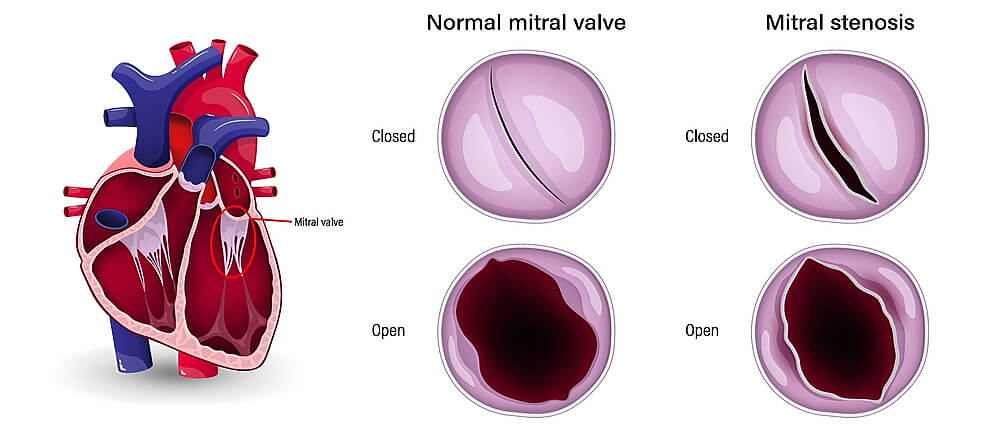B) Symptoms of rheumatic heart disease

The fibrosis of the valves may cause stenosis or regurge according to the degree of fibrosis.
1-Mitral stenosis:
The mitral valve becomes narrow through calcification, fibrosis, or fusion of its cusps. The stenosis prevents the blood flow from the left atrium to the left ventricle, which increases the pressure in the left atrium, leading to pulmonary congestion. Also, mitral stenosis decreases cardiac output, which is the amount of blood that your heart pumps every minute. If you have mitral stenosis, you may have:
- Pulmonary congestion:
- It is the accumulation of fluids in the lung, which may lead to dyspnea (shortness of breath), exertional cough, chest infection, hemoptysis (coughing blood), pleural effusion (fluids in the pleura), and pulmonary edema.
- Low cardiac output:
- Low blood supply to your body may make you feel with headaches, syncope (temporary loss of consciousness), cardiac ischemia, oliguria (urine output less than 400ml per day), fatigue, cyanosis (bluish skin), hypotension, and weak pulse.
2- Mitral regurge:
It means incomplete closure of the mitral valve, so the blood return from the left ventricle to the left atrium. Mitral regurge increases the pressure in the left atrium during systole (the time of ventricular contraction), which leads to pulmonary congestion then pulmonary hypertension. While during diastole, the blood flow through the mitral valve increases and leads to left ventricle enlargement then left side heart failure. If you have mitral regurge, you may have:
-
- Pulmonary congestion
- Pulmonary hypertension: is high pulmonary arterial blood pressure that may lead to right-side heart failure.
- Acute pulmonary edema: is a sudden accumulation of fluids in the lung. You may have shortness of breath, sweating, cyanosis, and cough.
3-Aortic stenosis:
The aortic valve narrows through fibrosis, calcification, or cardiomyopathy. Aortic stenosis obstructs the left ventricle outflow, which increases the pressure in the left ventricle, leading to left ventricular hypertrophy. Aortic stenosis may be asymptomatic for many years, and the symptoms appear suddenly. Also, obstruction of the left ventricular outflow decreases the cardiac output. If you have aortic stenosis, you may have:
-
- Low cardiac output
- syncope (temporary unconscious)
- Angina: it is chest pain due to decrease blood supply to your heart. You may complain of shortness of breath, sweating, and dizziness.
4- Aortic regurge:
It means incomplete closure of the aortic valve, so the blood return from the aorta to the left ventricle. Aortic regurge increases the volume overload on the left ventricle, which leads to left ventricular enlargement; left-side heart failure may occur.
Aortic regurge decreases the blood supply to the heart, which may cause angina. Also, large blood volume in the left ventricle causes high systolic blood pressure. You can feel your heartbeat during left ventricular contraction.
5-Tricuspid stenosis:
The tricuspid valve narrows through fibrosis. Tricuspid stenosis prevents blood flow from the right atrium to the right ventricle. Tricuspid stenosis usually occurs with mitral or aortic stenosis, not alone. Tricuspid stenosis increases the pressure in the right atrium, which leads to the right atrium enlargement, and systemic congestion may occur.
Tricuspid stenosis decreases RV filling, which reduces cardiac output. Right atrium enlargement may lead to tricuspid regurgitation. If you have tricuspid stenosis, you may have:
-
- Low cardiac output
- Systemic congestion: it is the accumulation of fluids outside the lung. You may have sweating, congested neck vein, enlarged liver, edema, and pleural effusion.


